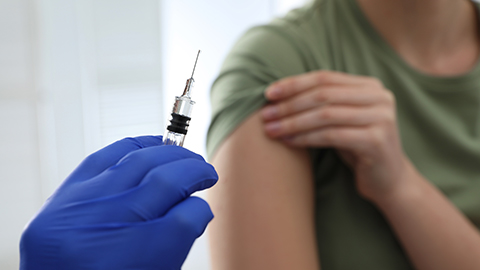
I received two letters in one week asking about massage in the context of allergies, allergy shots, and insect stings. What are best practices for clients who are receiving allergy shots? What about for clients who were recently stung? Is it possible that massage might create new allergies, or create a dangerous situation for a client who has recently been stung?
Resources: 
Pocket Pathology: /abmp-pocket-pathology-app
Allergy Shots – What You Need to Know | Yale Health (no date). Available at: https://yalehealth.yale.edu/more/allergy-shots-what-you-need-know (Accessed: 18 July 2022).
Allergy Shots (Immunotherapy) | AAAAI (no date). Available at: https://www.aaaai.org/tools-for-the-public/conditions-library/allergies/allergy-shots-(immunotherapy) (Accessed: 18 July 2022).
Allergy Treatments | AAFA.org (no date). Available at: https://www.aafa.org/allergy-treatments/?gclid=Cj0KCQjwidSWBhDdARIsAIoTVb3zQNIS2rB0saFCeRCQ9jvwPqsUQApy_tJL_647As0bwhOqRu1h3QUaAs09EALw_wcB (Accessed: 18 July 2022).
Facts and Stats - 50 Million Americans Have Allergies | ACAAI Patient (no date). Available at: https://acaai.org/allergies/allergies-101/facts-stats/ (Accessed: 13 July 2022).
MedlinePlus: Histamine: The Stuff Allergies are Made of (no date). Available at: https://medlineplus.gov/medlineplus-videos/histamine-the-stuff-allergies-are-made-of/ (Accessed: 14 July 2022).


Books of Discovery:www.booksofdiscovery.com
Advanced-Trainings: Advanced-Trainings.com
About Til Luchau and Advanced-Trainings:
As a Certified Advanced Rolfer™, Til was on the faculty of the Dr. Ida Rolf Institute® for 20 years, where he served as Coordinator and Faculty Chair of the Foundations of Rolfing Structural Integration program.
The author of the Advanced Myofascial Techniques textbook series (which has been translated into 6 languages), his regular Myofascial Techniques and Somatic Edge columns have been featured in Massage & Bodywork magazine since 2009, and (along with Whitney Lowe) he co-hosts the popular Thinking Practitioner Podcast.
He is the Director of Advanced-Trainings.com which since 1985 has offered short, credit-approved professional trainings and certification for manual therapists of all types, in person and online.
Website: Advanced-Trainings.com
Email: info@advanced-trainings.com
Facebook: facebook.com/Advanced.Trainings1/
Instagram: instagram.com/tilluchau
YouTube: youtube.com/user/AdvancedTrainings
0:00:00.1 S?: Til Luchau is pleased to invite you to Two Amazing Opportunities. Come to Til's popular hands-on sciatica training as it makes its Zoom debut on August 12th. Get a full day of personalized tutoring, camera-on supervision and permanent recordings and CE credit all at an amazing price. Til's new A-T subscription gives unlimited access to a growing catalog of over 35 curated advanced myofascial techniques, feldenkrais, and Zoga movement classes for body workers for as little as $20 per month. Sign up now at advancedtrainings.com.
0:00:47.8 Speaker 1: Hey, I Have A Client Who listeners, did you know I have a growing library of NCB-approved one-hour online self-paced continuing education courses that you can do any time, anywhere? Well, now you know. Current classes include, What's Next? COVID-19 Updates for Massage Therapists and A Massage Therapist's Introduction to Pharmacology, Part One, and brand new, A Massage Therapist's Introduction to Pharmacology, part two. Classes are $20 each and they confer one hour of continuing education credit. Wanna know more? Visit my website at RuthWerner.com and check it out. Be sure to sign up for my mailing list so you'll never miss a new class.
[music]
0:01:42.6 S1: Hi, and welcome to I Have A Client Who: Pathology Conversations with Ruth Werner, the podcast where I will discuss your real life stories about clients with conditions that are perplexing or confusing. I'm Ruth Warner, author of A Massage Therapist's Guide to Pathology, and I have spent decades studying, writing about and teaching about where massage therapy intersects with diseases and conditions that might limit our client's health. We almost always have something good to offer even with our most challenged clients, but we need to figure out a way to do that safely, effectively and within our scope of practice. And sometimes, as we have all learned, that is harder than it looks.
0:02:29.2 S1: In this episode, we're going to talk about one of my favorite topics, that's sarcasm, by the way, allergies. More specifically, we're going to talk about a frequently recommended way to deal with allergies: Allergy shots. And this is prompted by a letter that I got that goes like this: "I have a client who has been receiving regular allergy shots for years for his problem with pollen, mostly trees and grasses. Would it be a contraindication to have massage the same day or even the next day? I've always told clients not to schedule a massage for two days after a vaccine injection, flu, shingles, COVID, etcetera. Thanks for your time." And interestingly, within a few days, I had another note which asks this: "I wanted to ask about bee stings and injections. A co-worker of mine was taught that it's an absolute contraindication to massage a client within 72 hours of a bee sting or an injection due to the possibility of making them allergic to the bee sting or the medication being injected. I was taught that you treat the area as a local contraindication, and that if the body is going to have a histamine reaction, that is out of our control. I would love to hear your thoughts on this."
0:03:47.0 S1: Yeah, I would love to hear my thoughts on this too, so I guess I better think some thoughts about allergy shots, allergies. Does it seem like you and everyone you know is allergic to something? You're not making it up, allergies are far more prevalent than they used to be. We can have food allergies, those have doubled in about the last couple of decades, but also skin allergies and respiratory allergies, and these alone affect more than 50 million people in the United States each year, and they cost us about $18 billion in direct and indirect healthcare expenses. Respiratory allergies are the sixth leading cause of chronic illness in the United States. You are probably aware that allergies collectively are an immune system mistake. The immune system interprets some inherently benign substance like cat dander or ragweed pollen or peanut butter as though it's trying to kill us, and it launches an appropriately aggressive attack on the tissues that contact the allergen. That's sinuses or lungs, or the skin, or the GI tract. But here's the thing: Peanut butter doesn't damage cells, but your immune system response to peanut butter can kill you.
0:05:05.4 S1: A key player in the world of allergies is a chemical called histamine. There's actually a few different histamines. So I thought we'd better go into that just a bit. This will wander perilously close to chemistry, so I will keep it as brief and as simple as possible. Histamines are pro-inflammatory chemicals that are manufactured by immune system cells, they're especially good at triggering processes that help us get rid of potential invaders like parasites. Histamines make us cough and sneeze and have runny noses and itchy eyes. Histamines cause skin itching. That's another good way to get rid of potential intruders. And in the GI tract, histamines promote the production of stomach acid that's protective, and they increase gut motility, which means material moves through the intestines much more quickly. And that's all great when we're trying to get rid of cooties. But a big histamine reaction on its own can spell trouble, and that trouble can range from being mildly annoying, seasonal allergies to life-threatening swelling around the throat along with constricted airways, or system-wide anaphylaxis and circulatory shock. So, people who have severe allergies may try to limit how those allergies affect them.
0:06:26.2 S1: One way to do this is to use antihistamines, of course. Sometimes this is effective, but as you may be aware, these drugs can make us very sleepy, and they just don't work well for some people, and then there's that pesky pseudoephedrine issue that can make some brands of antihistamines inaccessible or at least inconvenient to get. Another point about antihistamines is that they work best if they are taken before allergens begin to elicit a histamine release because they occupy the uptake sites on targeted cells. If we take them after we're exposed to allergens, they compete for uptake with those allergens and they are less effective. I visited the Asthma and Allergy Foundation of America to get some information for this podcast, and they have some useful information about allergy shots, they also recommend the very common sense strategies of avoiding allergens, which of course conflicts with the allergy medication commercials of people frolicking in pollen-laden fields with clear eyes and dry noses, and they also suggest washing out nasal cavities each day with a saline rinse. In the section on immunotherapy treatments, they offer information about allergy shots and something I've never heard of before, sublingual immunotherapy.
0:07:46.2 S1: Let's talk about that first and then we'll get on to the topic of allergy shots. Sublingual immunotherapy involves small doses or exposures to certain allergens taken under the tongue, and this strategy is now available for dust mites and ragweed, and other targets are in development. This is an advantage over injections, of course, because the risk of adverse events is much less and it is way more convenient. But now I can't put this off any longer. It's time to talk about allergy shots. These involve repeated injections of identified specially-dosed allergens. They're given weekly or twice a week to build up to an appropriate dosage, and that process can take three to six months. And then in the maintenance phase, a person repeats treatments every two to four weeks for three to five years. If an adverse event to an allergy shot is going to happen, it's typically within the first 30 to 60 minutes of a dose, which is why patients must stay in the doctor's office for a while after each injection. Allergy shots have a record of some success for respiratory allergies, to pets, pollen and dust. It can also reduce sensitivity to insect stings, which can be a life-saving intervention, and it can improve asthma symptoms and allergic conjunctivitis, that inflammation of the outer layer of the eye. But allergy shots do not work for hives or eczema or food allergies.
0:09:17.3 S1: In reference to our contributors wondering about whether there's a risk with massage to elicit some adverse event with allergy shots, let's remember that these shots are titrated to start with an extremely low dose and then gradually build within the patient's tolerance. So the risk of creating a big inflammatory reaction seems remote. But if you have concerns, this could be a great question to ask the allergist, if the client gives you permission. A simple description of the kind of work you do, with the question, "Is there any possibility that this might trigger an allergic or inflammatory reaction?" Could get you the information you need. I bet the answer is, maybe stay away from the injection site if it's irritated, but otherwise, work as normal. That said, I did find one resource, this was from Yale Health, that discourages patients from exercising vigorously for two hours after their allergy shots. That seems like a decent guideline for massage therapy too. So let's land this here. For clients who are getting allergy shots, let's delay massage for at least a couple of hours after their treatment, and let's avoid the area of the injection if it's irritable. Another good accommodation is to make sure we're working in an allergy-friendly setting, no strong scents or scented candles in the room, hypo-allergenic lubricant, avoiding strong-smelling laundry detergent or fabric softeners.
0:10:45.4 S1: Now, I have not yet answered the whole question, we haven't discussed the issue of massage for someone who's just had a bee sting. Again, I looked for guidance about exercise as a decent analog for massage, and I ran straight into a brick wall. I found lots of advice to rest and not exercise for a day or two after a bee sting or a wasp sting, even for people who don't have a big dangerous reaction to venom. But none of those guidelines came from medical sources, they were all from people making best guesses. The only medical insect sting care guides that I found didn't mention anything about restricting exercise for people who are not at risk for major reactions. And remember, those develop within a few minutes of exposure to the venom. And you'll remember from our introduction today that one person said this, "A co-worker of mine was taught that it's an absolute contraindication to massage a client within 72 hours of a bee sting or an injection due to the possibility of making them allergic to the bee sting or to the medication being injected." I have to put on my skeptic hat again, I can't find anything that supports the idea that massage will make someone allergic to bee stings or to medication. But what is a good guideline for a client with a recent sting?
0:12:09.7 S1: Well, first, don't massage it. Really, this is advice for the stung person. Don't rub on it. Bee stings in particular can keep pumping venom into the site for a few minutes, and we don't need to do anything to promote that. If there is any swelling that gets worse and worse over the next few minutes, and especially if there's any sense of throat constriction or shortness of breath or faintness, this could be a medical emergency that needs immediate attention. Likewise, if there are multiple stings, like when my husband was using a hedge trimmer on a bush with a wasp nest for instance, this might require some serious benadryl or other interventions to manage swelling and pain. But for most people, this is a passing irritation and doesn't need to limit activities beyond the standard hygienic care of washing and covering the wound. So, there we have a bit of information about massage and allergies and allergy shots and bee stings. I wanna thank both of my contributors for their questions, because it gave me a chance to face up my attitudes about allergy shots and to share some really interesting information.
0:13:18.8 S1: Hey everybody, thanks for listening to I Have A Client Who: Pathology Conversations with Ruth Werner. Remember, you can send me your I Have A Client Who stories, to ihaveaclientwho@abmp.com, that's, ihaveaclientwho, all one word, all lowercase, @abmp.com. I can't wait to see what you send me, and I'll see you next time.